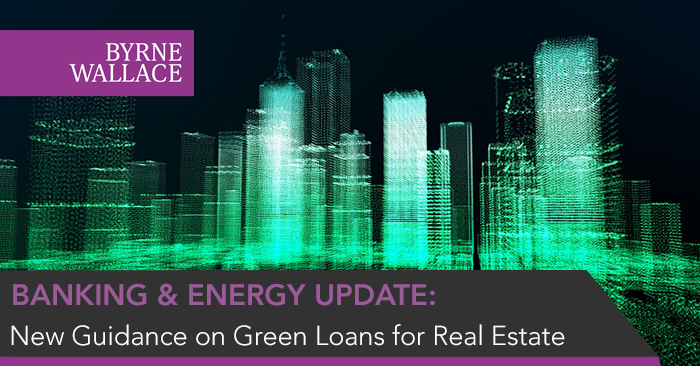New Guidance published by the LMA on application of Green Loan Principles in real estate finance
Thursday, 26 November 2020
On 22 October 2020, the Loan Market Association (LMA) launched two new guidance documents:
- Guidance on the application of the Green Loan Principles in the real estate finance (REF) investment lending context, in respect of green financing for new green buildings; and
- Guidance on the application of the Green Loan Principles in the real estate retrofit (RERF) lending context, in respect of green financing for the retrofit of existing buildings.
Each guidance document outlines the potential applications of the Green Loan Principles in the real estate context by addressing some of the most frequently asked questions on the application of the Green Loan Principles to real estate financing.
This follows the publication in May 2020 by the LMA, Loan Syndications and Trading Association and the Asia Pacific Loan Market Association of:
- updated Green Loan Principles, together with new Guidance on the Green Loan Principles (the Green Loan Guidance); and
- updated Sustainability Linked Loan Principles, together with Guidance on the Sustainability Linked Loan Principles (the SLL Guidance).
Green Loans, in particular in the real estate finance space, are becoming increasingly common in the loan market. ByrneWallace recently advised a multi-national retailer in connection with a Green Loan facility financing its new warehouse facility, which was awarded BREEAM certification.
What is a Green Loan?
Green Loans are any type of loan instrument made available exclusively to finance or re-finance, in whole or in part, new and/or existing eligible Green Projects.1 Where any portion of loan is intended to be used for non-Green Projects, only that portion of the loan that is designated for an eligible Green Project may constitute a Green Loan, with mechanisms in place to ring-fence Green Loan proceeds and avoid blending of Green and non-Green Loan funds (for example, separation into green and non-green tranches).
Green Loans are commonly aligned in the market with the Green Loan Principles (GLP), a framework of market standards and guidelines comprised of four key pillars:
- Use of Proceeds;
- Process for Project Evaluation and Selection;
- Management of Proceeds; and
- Reporting.
Alignment of a Green Loan with the GLP is typically addressed by way of undertakings, representations and conditions contained within the loan documentation relating to the use of proceeds, conditions to drawdown, supporting evidence, reporting requirements (both in respect of use of funds and the green performance of the building) and any required reviews/audits. Parties should also consider if a breach of any of these provisions may result in the loss of a benefit (for example, a more favourable margin) or, in the case of a more fundamental breach, would give rise to an event of default. In certain instances, a lender may require that serious breaches (such as failure to apply the proceeds of a Green Loan towards an eligible Green REF Project), would trigger an event of default, which may have consequences for the borrower’s other outstanding loans.
Green Loans in the Real Estate Finance context
In order to meet our net zero emissions climate target by 2050, which has been set by the EU and is set to be incorporated into Irish law on enactment of the Climate Action and Low Carbon Development (Amendment) Bill 2020, significant investment in buildings, which account for approximately 40% of energy consumption and 36% of CO2 emissions in the European Union2, will be required to reduce each building’s carbon footprint and improve energy efficiency.
This will involve a number of new design strategies, technologies and practices that, inter alia:
- reduce consumption of resources associated with buildings, for example, use of green building materials or adapting traditional building methods, installation of sanitary water-efficient applications and roof-mounted rainwater collectors;
- reduce energy consumption by switching from fossil fuels to low/ no-carbon fuels, for example, renewable energy generated on-site; switching to energy utilities that source energy from renewable sources only; and
- promote and encourage behaviours towards sustainable lifestyles, for example, introduction of sustainable real estate certifications, requirement for dedicated biodiversity areas, etc.
Green Loans enable finance providers to contribute to a more sustainable future by directing capital into environmentally sustainable economic activities, with recent demand for green financing for buildings on an upward trend. Initial concerns of finance providers, in relation to a lack of data in this area, have been steadily decreasing as green finance products have become more popular with data now available for use by finance providers to assess a building’s environmental credentials against other comparable real estate.
Advantages from a finance provider’s perspective in relation to the funding of the construction of green real estate includes the potential to command higher rents, achieve higher occupancy rates and obtain higher valuations than with non-green buildings, thereby improving both the value of the finance provider's security and the borrower’s ability to repay the loans.
Eligible Green Projects
There are no specific criteria by which a real estate project would be deemed an eligible Green Project.
Finance providers may have their own eligibility criteria or may rely on external reviews or may make a case-by-case determination of whether a given real estate finance project constitutes a Green Project, for example, where financing or refinancing the acquisition and development of green real estate, or capital expenditure to retrofit existing buildings to make them more sustainable in order to contribute to climate change mitigation. In any event, the eligibility criteria of a Green Project should be clearly agreed and documented by the parties.
A Green Loan Framework may also be prepared by a borrower setting out their background and overall sustainability strategy (albeit Green Loans focus on the eligible projects rather than on the sustainability profile of the borrower itself), together with details of the proposed eligible Green Project to be financed by the Green Loan. While preparation of a framework document is not a specific requirement under the GLP, it is a useful tool as it allows both borrower and finance provider an opportunity to assess and seek clarifications to ensure the proposed project meets both parties’ eligibility criteria, sets out how the project complies with each of the four pillars of the GLP, and helps ensure transparency and mitigate against the risk of greenwashing.
Parties should avoid a scenario where a charge of greenwashing may arise. The term ‘greenwashing’ is used to describe a scenario in which a project is held out to have green credentials, but those claims are misleading, inaccurate or inflated.
Green Real Estate
At present there is no universal standard as to what can be classified as green real estate, but various external green standards and certification systems may evidence the green character of a building. Given advances in sustainable design and climate mitigating technologies, buildings may lose their green status over time and it is important that finance providers bear this in mind when agreeing the eligibility criteria and drafting the finance document, particularly where the allocated funds are intended to be drawn after the completion date in order that conditions precedent to subsequent drawdowns may address any additional requirements.
Certification
There are a number of different standards and certifications that may assist with determining the green credentials of a building depending on the score or rating obtained by the building across a number of categories. Finance providers may wish to include in the loan documentation a requirement for buildings to obtain a minimum rating in order to be considered eligible for financing via a green loan, for example, a BREEAM certified rating of Excellent or Outstanding.
On a final note, not all loan products labelled as “green” qualify as Green Loans for the purposes of the GLP as they may not satisfy all the requirements of the GLP as to use of proceeds, process for project evaluation and selection, management of proceeds and reporting. For example, while finance for the purposes of construction of wind farms may be considered “green”, this on its own may not be sufficient for meet the criteria set out in the GLP.
For further advice and information on green loans, please contact Paraic O’Kennedy or Karen Outram from the Banking and Finance team or a member of the Energy and Natural Resources team.
Notes
1 LMA Green and Sustainable Lending Glossary

